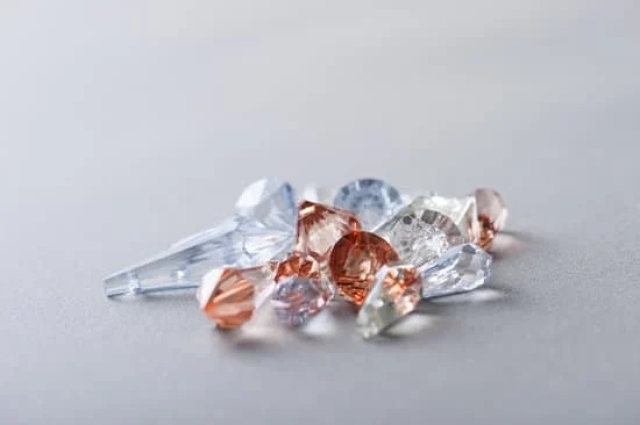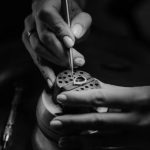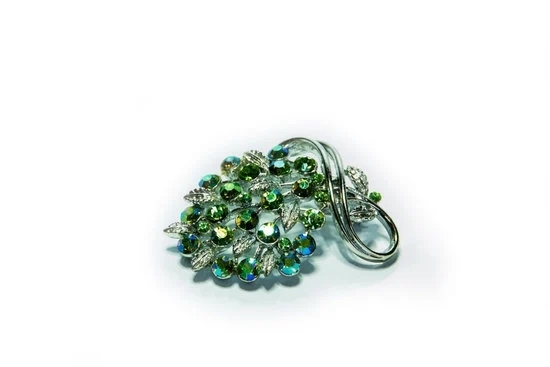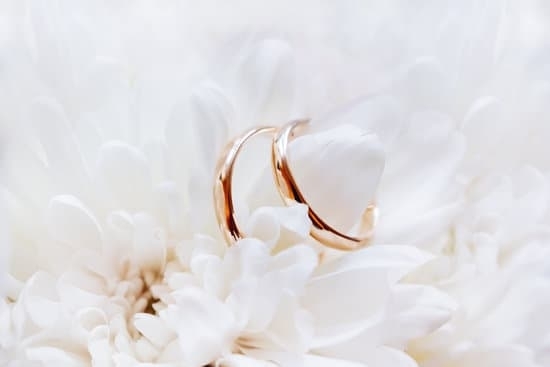The Retro Jewelry Style Period is an era of jewelry design representing the look that was popularized in the 1920s and 1930s, following up until WWII. It includes a range of styles from Baroque to Art Deco, typically featuring diamonds, pearls and precious metals. Additionally, one will find vibrancy in the brightly colored stones as well as an emphasis on craftsmanship and intricate detail.
Materials Retro jewelry incorporates a variety of materials that lend to its distinct style. For example, pieces often feature yellow or white gold as well as platinum for settings while diamond cuts such as baguette cuts are used for accents.
Other semi-precious stones such as emeralds, rubies and sapphires can also be found along with glass beads for added flare. Pearl accents were also prevalent during this period making for unique pieces that tend to be cherished heirlooms rather than disposable fashion items.
Popular Styles The traditional motifs found in retro jewelry vary by style yet share the common thread of luxury allure that has stood the test of time throughout history’s changing trends.
For instance, Art Deco design features bold geometric shapes and symmetrical patterns that often incorporate unexpected accents set against vibrant precious stones while Renaissance Revival pieces display ornate designs inspired by medieval artifacts such as crosses and crowns adorned with precious gemstones embedded into a sea of filigree detailing.
Another popular style is Baroque which combines intricate scrolls combined with a repoussé technique showcasing depth and dimension creating elaborate statement pieces that remain classic over time.
Origins
Retro jewelry style began in the 1920s and was influenced by mass production, improved technology, celebrity endorsement, and a surge of optimism after World War I. This period brought about a proliferation of costume jewelry as more people were able to afford it.
Retro jewelry includes such things as plastic accessories from the 1940s, brass jewelry from the 1950s and 60s, ethnic-inspired enamel pendants from the 1970s, and baroque-style pieces from the 1980s. While trends were largely determined by fashion houses at this time, it can still be said that there is a distinctive retro aesthetic that comes through in most pieces from this period.
Specific Key Influences for Retro Jewelry Style
The 1920s saw an increase in disposable income due to rising wages, which contributed to the popularity of costume jewelry. This decade was also known for its flapper-style clothing with intricate beadwork and sparkly rhinestones. Art Deco emerged as an influential style at this time, popularized by celebrities like Greta Garbo wearing bold geometric designs featuring precious stones such as onyx, diamond, or sapphire set into gold or silver settings.
By the 1930s we see a blend of classical design elements with modern materials such as plastics being used for pendants and necklaces; Bakelite was also being shaped into bangles during this period. Going into the 40s and 50s there was an emphasis on glass beads and plastic charms set into metal bases for jewellery designs.
Skyrocketing demand for vintage jewellery began in these decades too with lucite bangles featuring abstract print motifs becoming particularly fashionable. Enamel pieces were also popular due to their bright colored palette – this use of color remains central to many Retro pieces today.
Accessories Used Adornment Of The Retro Look
Finally we come to the 1960s where funky hippie influences are felt; tassels became a key element of accessorizing. Colourful earrings made out of beads, pearls and wood provided a great way to complete any outfit with a care free boheme psychedelic feel; necklaces featuring brass medallions suspended on long strands were all part of the look too.
Of course no retro outfit would be complete without retro sunglasses – bright cat eyes frames being very popular – along with head scarves so you can mimic Brigitte Bardot’ s iconic style.
With all these influences considered, you begin to develop an appreciation for how truly diverse, layered and complex true vintage or rather ‘retro’ jewellery really is. Taking inspiration from across multiple eras (spanning over half century) gives our modern day fashion access to a variety of truly unique jewellery pieces that won’t be easily found elsewhere ; allowing individuals who love vintage looks express themselves freely while holding true to classic aesthetic history.
Characteristics
Retro jewelry was a popular style in the 1940s and ’50s, dates recognized as some of the greatest eras for jewelry making. Retro jewelry looked quite different than the pieces we often see today: it was bold, vibrant, colorful, and above all else a reminder of a glamour era gone by. This style period can be identified by certain characteristics which set it apart from more modern designs.
- Feminine Floral Designs
- Use of Synthetic Gemstones
- Large Pin Brooches
- Sculptural Pieces
Retro jewelry pieces during this period were most often created with feminine motifs like flowers and birds with intricate details that were almost cartoonish in their execution. Synthetic gemstones like marcasite, moissanite, cubic zirconia, and glass rhinestones were also used in many of these styles – all materials designed to imitate natural gemstones but much less expensive.
The sparkling artwork adorned across necklaces, earrings and bracelets as well as large brooch pins worn on clothing or hats instantly became classic signature accessories of the retro style era. Sculptural forms became popular around this time as well; anomger seen employed in fine retro pieces is that of abstract symbolism commonly found in Greek or Egyptian artifacts – bringing attention to particular parts or design elements with a unique look and feel.
Famous Pieces
Retro jewellery has a special quirkiness to it, that makes it a standout among the other jewellery designs. From cocktail rings to elaborate necklaces, retro pieces add a dash of playfulness and individuality that are difficult to replicate with modern techniques and materials. The following are some of the most famous examples of Retro jewelry:
- Cartier Tank watches
- Van Cleef & Arpels “Alhambra”
- Elsa Perettis’s “Open Heart” collection
- Chopard’s signature tennis bracelet
- Tiffany & Co.’s “Return to Tiffany” heart tag necklace
The Cartier Tank watch is perhaps one of the most iconic pieces of retro jewelry – featuring an effortlessly chic aesthetic with its classic design and signature blue hand movement. The ‘Alhambra’ collection by the luxury French jewelry house Van Cleef & Arpels, takes inspiration from Spanish Moorish architecture to create intricate yetsophisticated pieces graced with their signature yellow gold clover motifs – taking vintage glamour to another level.
Likewise, Elsa Peretti has delighted us with her precious designs such as her widely acclaimed ‘Open Heart’ necklace and ring set; which feature an openworked design that garners many admirers for its elegance as well as distinctiveness.
The Chopard Tennis Bracelet is another iconic piece that concentrates on fluidity and simplicity without compromising on style or sophistication – offering timeless allure through its intertwined diamond-embellished links in yellow gold plating. Lastly, Tiffany & Co’s ‘Return to Tiffany’ heart tag necklace remains iconic more than two decades after its initial release; exemplifying unadorned beauty with its sterling silver heart charm on a sober chain.
This particular piece has become a symbol for courting couples around the world – reflecting the sheer power and sentimentality behind each creation from this mastery era of jewelry design.
Popularity
The late 90’s was a time of great influence for the Retro Jewelry Trend. Women were seen wearing bold chunky pieces and modern takes on some classics like pearl necklaces and brooches that added a unique blend of retro glamour that was perfect for the decade.
It was an era of little restraint and extravagance in fashion, with the resurgence of clothes with over-the-top details like Victorian lace, ruffles, bright colors, exaggerated embroidery, collared blouses and high-waisted pants. To capture this same opulent mood in jewelry, designers looked to heirlooms and sought to copy their glitzy style by adding faux stones, ornate metalwork and a generous use of crystals.
Influences Behind This Revival
The idea behind Retro Jewelry as we know it today can be attributed to the highly influential movie-mogul costume designs from 1920’s Hollywood and other timeless beauty looks such as the 1950’s pinup girl aesthetic. Another influence is Art Nouveau that became common fashion jewellery favoured by Pop culture icons including Marilyn Monroe who introduced us to the allure of sparkle with her Swarovski crystal globe earrings adorned in gold settings during the golden era of films.
Third Wave Of Popularity
Since then, this style of jewellery made another comeback at the end of last century however this revival centred more around antique Victorian styles which often featured intricate filigree patterning crafted from sterling silver or 14k golld along with sterling moonstones set in interesting halo formations or flashes of gemstone cabochons.
This wave built up popularity throughout 2000’s leading to established brands such YSL collaborating with some high-end jewelers such as Mikimoto and TAG Heuer creating pieces framed in delicate diamonds in creative compositions which pushed this traditionalist style further towards modern times.
Sub-Styles
- Art Deco: This style was popular in the 1920s and 1930s. It typically features geometric shapes, such as trapezoids and chevrons, bright colors, and gems set in unusual arrangements. Art deco jewelry often used platinum or white gold to give it an extra sparkle.
- Mid-Century Modern: Popular during the 1940s and 1950s, mid-century modern jewelry pieces are characterized by simple designs with an emphasis on line-work. They usually featured lightweight materials like brass or silver plated metals, as well as bold shapes like rectangles and triangles.
- Hollywood Glamor: Jewelry from this period is perhaps some of the most iconic. Taking inspiration from classic 1950’s films, these pieces had intricate designs featuring gold and diamond accents such as stars or hearts. Many Hollywood Glamor jewels also incorporated vintage costume pearls to add to their drama.
- Space Age: This style emerged around the mid-1960s when advancements made exploration of space possible. Jewelry from this sub-style features bold abstract patterns that draw references from nature such as starbursts, asteroids, comets, planets, galaxies, etc., crafted out of plastic or lucite material.
This type of retro jewelry is often associated with its vibrant colors and extravagance; big earrings set with precious stones alongside structured necklaces with accompanying brooches showcasing a range of gemstones that were very popular during these eras.
The use of multiple types of metal combinations in one piece was particularly fashionable too – gold, silver and copper tones were commonly blended to create a unique look for each piece regardless if it was traditional setting for something more modern looking such as highly polished finished metal work combined together to make chic statement pieces that are timelessly wearable.
Trends
Retro jewelry has become increasingly popular over the past few years as the style has regained prominence. This classic look is often seen in fashion magazines, on celebrities and can be worn for any occasion. Retro jewelry styles include a variety of colors, materials and shapes that capture the nostalgia of decades gone by. Below are some of the trending pieces in this timeless style:
- Statement Necklaces – Chunky necklaces with vibrant gemstones and intricate details have been popularized by celebrities like Rihanna. These necklaces make a bold statement while still giving off subtle retro vibes.
- Colored Stones – The late 2000s brought about a resurgence of colored stones such as turquoise, aquamarine and jade in jewelry designs. Retro designers mixed these colorful stones with silver to really bring out their luminosity.
- Vintage charms – Vintage charms were also popular during this era. Sixties rosary necklaces layered with vintage charms give off an old world charm in modern accessories.
- Pearls – Pearls never seem to go out of style although they came into particular prominence at this time. From pearl studs to larger strands used as bracelets or necklaces, these classic gems come back year after year.
- Metallic rings – Rings featuring bold geometric designs in gold finishes first made an appearance during this era. Metallic rings accessorize any look while preserving a fashionable, chic edge.
The exciting thing about retro jewelry is its versatility; these pieces transcend age groups, genders and cultures no matter where one lives or what trend is currently going around the globe. It’s always interesting to explore what was once fashionable decades ago and to modernize it with contemporary elegance.
These iconic pieces are both fashionable and timeless – they bring instant glamor and luxury to any look while offering unique characters that will bring out individuality from others who wear them too.
Collecting
Retro jewelry style reflects the deep history of fashion trends. As fashionable styles have evolved over the years, some looks have come and gone, while others are still popular today. This type of jewelry also can be seen as reflecting a certain era in modern history.
Its beauty is often more muted or sophisticated than current fashions, and it adds an air of sophistication to any outfit. Retro jewelry may feature world-inspired designs like Native American or South Pacific motifs. To commemorate a special moment in contemporary style, collectors should consider collecting retro jewelry style pieces.
Enthusiasts Should Consider Several Factors for Collecting Retro Jewelry
Collectors of retro jewelry should consider several factors before investing in any piece:
- Material: Depending on the era it represents, vintage or antique pieces may be made from different materials such as gold, silver, copper/ bronze, brass or other mixed metals.
- Design: The influences of regional culture will influence the design elements in period pieces which could include floral embellishments or symbols.
- Condition: Carefully examine the condition of each item before purchasing it. Check that there are no nicks or blemishes and make sure all clasp and hinge mechanisms function correctly.
- Authenticity: Depending on the value attributed to a unique item like Art Deco designs from Europe to mid-century Mexican sterling pieces be sure to request authentication documentation.
: Investing Wisely is Essential for Maintaining Value
When it comes to investing in period pieces smart shoppers ensure they get real value for their money. It’s best to talk with established jewelers and dealers who have decades of experience in dealing with quality traditional pieces.
They often can act as excellent resources if you’re starting out as a collector because they can advise shoppers on which items offer the most potential for investment such as signed designs from leading designers like Cartier or Chanel Couture collections depending on trend cycles year-to-year. Additionally its important to select items that offer long-term value backed by quality craftsmanship versus temporarily fashionable items which go out of favor quickly and depreciate over time.
Care Considerations
Retro jewelry, dating from the 1925 to 1975 period, is highly popular due to its stunning designs and unique charm. Whether it’s a family heirloom or purchased piece, possession of such high quality jewelry requires proper care and maintenance. The following is an overview of the specific considerations that should be kept in mind when caring for retro jewelry:
Cleaning
- Use a mild soap solution with warm water and soft brush for cleaning.
- Cleaning can be done at home or taken to a jeweler to ensure maximum safety – avoid using harsh chemicals such as ammonia as this may damage stones.
- Due to the fact that some antique settings may not include modern assurances against water or dirt intrusion, prudence dictates removing pieces when performing activities that increase the likelihood of contact with liquids (washing dishes, showering, swimming).
Storage
- Only store antique jewelry in fabric-lined cases designed specifically for jewelry.
- Never mix metals as this can cause scratching.
- Ensure pieces are kept away from direct sunlight as fading could occur.
- If possible, use anti-tarnish strips or silica gel sachets to keep moisture content low.
Preservation
A craze that has been slowly gaining momentum over the past few years is that of wearing vintage or retro jewelry. These pieces often hold a special place in people’s memories, as they were acquired from a family member or heirloomed by another whom they admire. They evoke a sense of nostalgia for time gone by, and in some cases can be worth quite a lot of money due to their age and rarity.
With all these reasons, preserving them is essential for many wearers. Here are some tips on how to do just that:
Cleaning
Perhaps the most important step in the preservation process is cleaning. Over time, an accumulation of dirt and oil, sweat, skincare products, perfumes and more can cause discoloration, wear-and-tear and other damage to retro jewelry.
Taking it off before showering or washing dishes to avoid water damage is key but not enough on its own – regular cleanings with a professional-grade jewelry cleaner should be done at least bi-annually. Certain metals like silver may require more frequent attention; tarnishing is common when exposed to air which will contribute to detriment if not regularly maintained properly.
Storage
Failing to store your retro jewelry appropriately could have detrimental effects on the longevity of your piece – so it’s important understanding what storage measures are suitable for each type of metal used (e.g., gold vs silver).
If you opt for storing multiple items together rather than individually separate pieces, using soft fabric such as velvet for lining the box you’ve chosen is considered optimal; not only does this protect the metal but also limits contact between different materials where appropriate (such as pairing two chains made from different types of metal).
Additionally, bags specifically designed for storing trinkets / jewelry prevent oxidation or friction damage occurring within tight corners or confined spaces – thus ensuring delicate clasps remain intact too.
Neutralize Acids
As acids are extremely corrosive substances which may interact with metals – thus damaging both an item’s beauty as well as removal value – it’s essential one take steps prior to handling / wearing any form of retro jewelry with proper neutralization techniques. For instance, typical household bleaches such as those containing hydrochloric acid must be avoided when dealing with items composed primarily of silver; instead opt for mild dish soap mixed with warm water which works wonders.
An additional layer precaution would be investing in polishing cloths specifically designed react positively against various forms corrosion, perfect when looking to keep your investment shining bright despite constant wear & tear over time.
Conclusion
The retro jewelry style period was a short but important movement in the fashion industry. It is the time of our lives when fashion made its statement, and it has done so ever since. From the 1920s to the 1950s, retro jewelry was embraced by those looking for a unique visual representation of themselves.
This style period focused on classic elements like pearls, cubic zirconia, and animal heads. Jewelry from this period featured bright colors and eye-catching designs that made it stand out from other traditional pieces of jewelry.
When considering why people became so intrigued by this jewelry style era, one must remember that society’s aesthetic tastes were changing rapidly during this time. Many people wanted to express their individuality and stand out from the crowd.
By wearing vintage-inspired pieces like those created during this era, they could make a lasting impression without having to conform to traditional ideals of beauty and fashion. It was very empowering for individuals to be able to flaunt their own unique style while still mixing modern day trends with classic motifs for an overall polished look.
Overall, jewelry created during the Retro Style Era remains popular among modern day customers who appreciate its uniqueness and timelessness in styling. Rings, necklaces, earrings, and other pieces still showcase intricate details that capture attention wherever they are worn.
These items appeal to different generations as well since many are seen as antiques that evoke nostalgia for days long gone past; even today’s millennials have been known to find fashionable inspiration in vintage looks.
The combination of classic designs coupled with unconventional aesthetics is what makes these pieces so special; no matter how old or new they may be, vintage items such as these will always be appreciated for their craftsmanship, artistry and staying power against changing trends in fashion circles all over the world.

Welcome to my jewelry blog! My name is Sarah and I am the owner of this blog.
I love making jewelry and sharing my creations with others.
So whether you’re someone who loves wearing jewelry yourself or simply enjoys learning about it, be sure to check out my blog for insightful posts on everything related to this exciting topic!





